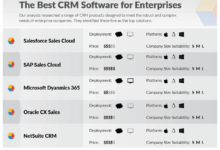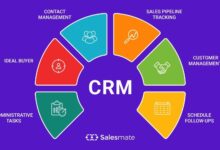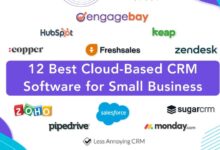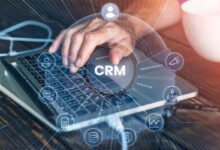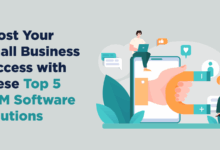Best Enterprise CRM Solutions: A Comprehensive Guide
Best Enterprise CRM Solutions are crucial for businesses aiming to streamline operations and enhance customer relationships. This guide delves into the critical aspects of selecting, implementing, and maximizing the return on investment (ROI) of an enterprise CRM system. We’ll explore key features, deployment models, cost considerations, and crucial security measures, all while providing a framework for making informed decisions in this vital area of business technology.
From defining what constitutes a “best” solution based on relevant KPIs to navigating the complexities of vendor selection and implementation, we’ll equip you with the knowledge to choose the right CRM system for your specific needs. We will also examine real-world examples of successful CRM deployments to provide tangible insights and practical strategies for success.
Defining “Best” Enterprise CRM Solutions
Selecting the “best” enterprise CRM solution isn’t a simple task; it’s a multifaceted decision heavily reliant on the specific needs and context of the organization. There’s no one-size-fits-all answer, and what constitutes “best” varies considerably depending on industry, size, existing infrastructure, and business goals. This necessitates a thorough evaluation process considering several key factors.
Factors Contributing to CRM Effectiveness in Enterprises
A truly effective enterprise CRM system must seamlessly integrate with existing business processes, enhance operational efficiency, and provide actionable insights to drive strategic decision-making. Several crucial factors contribute to a CRM’s overall effectiveness within a large organization. These factors can be broadly categorized into functionality, scalability, integration, and user experience. The ideal solution will excel across all these areas.
- Functionality: The CRM should offer a comprehensive suite of features tailored to the organization’s specific needs, including sales force automation (SFA), marketing automation, customer service management, and potentially more specialized functionalities like field service management or project management. Robust reporting and analytics capabilities are also essential.
- Scalability: The system must be able to handle the organization’s current data volume and user base while readily scaling to accommodate future growth. This includes considerations of data storage, processing power, and user licensing.
- Integration: Seamless integration with existing enterprise systems (ERP, marketing automation platforms, etc.) is paramount. Data silos hinder efficiency and insights; a well-integrated CRM eliminates these barriers and facilitates a holistic view of the customer.
- User Experience (UX): A user-friendly interface is critical for adoption and productivity. The system should be intuitive, easy to navigate, and provide a positive experience for all users, from sales representatives to customer service agents.
- Security and Compliance: Robust security measures and adherence to relevant industry regulations (e.g., GDPR, CCPA) are crucial to protect sensitive customer data and maintain compliance.
Key Performance Indicators (KPIs) for Enterprise CRM Success
Measuring the success of an enterprise CRM implementation requires a focused approach using relevant KPIs. These metrics should align directly with the organization’s strategic objectives and provide quantifiable evidence of the CRM’s impact. Monitoring these KPIs allows for continuous improvement and optimization of the system.
- Sales Performance: Metrics like sales conversion rates, average deal size, sales cycle length, and revenue generated can demonstrate the direct impact of the CRM on sales effectiveness. For example, a 15% increase in conversion rates following CRM implementation would be a strong indicator of success.
- Customer Satisfaction: Customer satisfaction scores (CSAT), Net Promoter Score (NPS), and customer churn rate provide insights into the CRM’s contribution to improved customer relationships. A 10-point increase in NPS after implementation could be significant.
- Marketing ROI: Tracking marketing campaign effectiveness, lead generation rates, and cost per acquisition (CPA) helps assess the CRM’s role in improving marketing efficiency. A reduction in CPA by 20% would indicate a positive return on investment.
- Customer Service Efficiency: Metrics like average handling time (AHT), first contact resolution (FCR), and customer service satisfaction scores indicate the CRM’s impact on customer service operations. A 10% reduction in AHT demonstrates improved efficiency.
- Data Quality and Accuracy: Monitoring data completeness, accuracy, and consistency is vital for ensuring the reliability of insights derived from the CRM. A significant improvement in data quality, measured by a reduction in error rates, indicates better data management.
Framework for Comparing CRM Solutions
A structured approach is crucial when comparing different CRM solutions. This framework allows for a fair and objective evaluation based on the previously discussed factors and KPIs.
| Criterion | Rating Scale (1-5, 5 being best) | CRM A | CRM B | CRM C |
|---|---|---|---|---|
| Functionality | 1-5 | 4 | 3 | 5 |
| Scalability | 1-5 | 3 | 5 | 4 |
| Integration Capabilities | 1-5 | 5 | 4 | 3 |
| User Experience | 1-5 | 4 | 4 | 3 |
| Security and Compliance | 1-5 | 5 | 4 | 5 |
| Sales Conversion Rate Improvement (Projected) | % | 12% | 15% | 8% |
| Customer Satisfaction Score Improvement (Projected) | Points | 8 | 5 | 10 |
| Marketing ROI Improvement (Projected) | % | 15% | 20% | 10% |
Top Enterprise CRM Solution Features
Choosing the right enterprise CRM solution requires careful consideration of its core functionalities. A robust system offers more than just contact management; it empowers businesses to streamline operations, enhance customer relationships, and drive revenue growth. This section will delve into the essential features that distinguish leading enterprise CRM solutions and how they contribute to overall business success.
Essential Features of Leading Enterprise CRM Solutions
Five key features consistently appear in top-rated enterprise CRM systems. These features, while individually powerful, become even more effective when integrated within a comprehensive platform. The following table compares these features across hypothetical vendors (Vendor A, Vendor B, and Vendor C) to illustrate the potential variations in implementation and functionality. Note that specific features and capabilities can vary significantly depending on the vendor and chosen licensing package.
| Feature | Vendor A | Vendor B | Vendor C |
|---|---|---|---|
| Contact Management | Comprehensive contact database with advanced search and filtering; robust segmentation capabilities. | Detailed contact profiles with integrated social media data; customizable fields and workflows. | Centralized contact repository with robust data import/export functionality; strong collaboration tools. |
| Sales Force Automation (SFA) | Lead management, opportunity tracking, sales forecasting, and pipeline visualization. | Automated sales process workflows; integrated communication tools (email, phone, chat); mobile accessibility. | Real-time sales performance dashboards; advanced reporting and analytics; integration with sales intelligence platforms. |
| Customer Service Management (CSM) | Case management, ticketing system, knowledge base integration, and self-service portals. | Omnichannel support (email, phone, chat, social media); automated routing and escalation; service level agreement (SLA) management. | AI-powered chatbot for initial customer support; sentiment analysis of customer interactions; proactive issue resolution. |
| Marketing Automation | Email marketing, campaign management, lead nurturing, and marketing analytics. | Automated email sequences based on customer behavior; A/B testing capabilities; integration with marketing analytics platforms. | Personalized email marketing campaigns; predictive lead scoring; multi-channel marketing campaign orchestration. |
| Reporting and Analytics | Customizable dashboards and reports; key performance indicator (KPI) tracking; data visualization tools. | Advanced reporting capabilities with drill-down functionality; real-time data analysis; predictive analytics. | Integration with business intelligence (BI) tools; data mining capabilities; custom report generation. |
Advanced Features Enhancing Enterprise CRM Effectiveness
Advanced features such as AI-powered insights and predictive analytics significantly boost enterprise CRM effectiveness. For instance, AI can analyze customer data to identify patterns and predict future behavior, enabling proactive engagement and personalized experiences. Predictive analytics can forecast sales trends, optimize marketing campaigns, and improve customer service efficiency. A hypothetical example: an AI-powered CRM could identify customers at high risk of churn based on their recent activity and interactions, allowing the sales team to proactively intervene and retain them. This proactive approach minimizes customer loss and maximizes customer lifetime value.
Integration Capabilities with Other Business Software
Seamless integration with other business systems, such as Enterprise Resource Planning (ERP) software and marketing automation platforms, is crucial for a holistic view of customer interactions and operational efficiency. Integrating CRM with ERP systems, for example, provides a unified view of customer data, sales transactions, and inventory levels. This allows for more informed decision-making across departments, leading to improved efficiency and customer satisfaction. Similarly, integration with marketing automation tools allows for targeted marketing campaigns based on CRM data, optimizing marketing ROI and enhancing customer engagement. A successful integration could streamline order processing, automate invoice generation, and provide real-time inventory updates to sales representatives.
Deployment Models and Scalability
Choosing the right deployment model for your enterprise CRM is crucial for its long-term success. The model you select directly impacts factors such as cost, security, scalability, and overall user experience. Understanding the strengths and weaknesses of each approach is paramount before making a decision.
Enterprise CRM solutions are typically deployed using one of three primary models: cloud-based, on-premise, and hybrid. Each offers a unique set of advantages and disadvantages regarding scalability, security, and cost. The optimal choice depends heavily on the specific needs and resources of the organization.
Deployment Model Comparison
The following points highlight the key differences between cloud-based, on-premise, and hybrid CRM deployments. Consider these factors carefully when selecting a deployment model for your enterprise.
- Cloud-based: This model involves hosting the CRM software and data on a third-party provider’s servers. It offers high scalability and accessibility, with minimal upfront investment in infrastructure. However, reliance on a third-party provider introduces concerns about data security and vendor lock-in. Scalability is generally handled by the provider, often automatically adjusting resources based on demand. Examples of cloud-based CRM providers include Salesforce, Microsoft Dynamics 365, and SAP Cloud for Customer.
- On-premise: In this model, the CRM software and data reside on the organization’s own servers, giving the company complete control over its data and infrastructure. This offers greater security and customization options but requires a significant upfront investment in hardware, software, and IT personnel. Scalability requires proactive planning and investment in additional hardware and resources as the business grows. Maintaining and upgrading the system also adds to the operational overhead.
- Hybrid: A hybrid approach combines elements of both cloud-based and on-premise deployments. Certain aspects of the CRM system, such as sensitive data or mission-critical applications, might be hosted on-premise, while less sensitive data or functionalities are hosted in the cloud. This approach offers a balance between control and cost-effectiveness, allowing organizations to leverage the benefits of both models. For example, a company might store customer contact information in the cloud for easy access by sales teams while keeping financial transaction data on-premise for enhanced security.
Scaling an Enterprise CRM Solution
Scaling an enterprise CRM solution involves adapting the system to accommodate growth in both the user base and data volume. This requires careful planning and consideration of various factors. Failure to adequately plan for scalability can lead to performance bottlenecks, system instability, and ultimately, business disruption.
Key considerations for scaling include:
- Predicting future growth: Accurate forecasting of user growth and data volume is crucial for making informed decisions about infrastructure and resource allocation. This involves analyzing historical trends, considering business expansion plans, and incorporating industry benchmarks. For example, a rapidly growing startup will need a more aggressive scaling strategy than a mature, established company.
- Choosing the right infrastructure: The choice of deployment model significantly influences scalability. Cloud-based solutions generally offer more flexibility and ease of scaling, while on-premise deployments require more proactive planning and investment in additional hardware and software. Hybrid models allow for a more tailored approach, combining the strengths of both cloud and on-premise solutions.
- Optimizing database performance: As data volume increases, database performance can become a bottleneck. Strategies for optimizing database performance include database indexing, query optimization, and database sharding (partitioning the database across multiple servers).
- Load balancing and redundancy: Implementing load balancing distributes traffic across multiple servers, preventing overload on any single server. Redundancy ensures system availability in case of server failure. These measures are critical for maintaining system performance and stability during periods of high demand.
Security and Data Management Implications
The chosen deployment model significantly impacts security and data management practices. Each approach presents unique challenges and opportunities in protecting sensitive customer data and maintaining data integrity.
- Cloud-based: Security relies heavily on the third-party provider’s infrastructure and security protocols. Organizations need to carefully evaluate the provider’s security certifications and compliance with relevant regulations (e.g., GDPR, CCPA). Data encryption, both in transit and at rest, is critical. Data loss prevention (DLP) measures are also necessary.
- On-premise: Organizations have greater control over security but bear the responsibility for implementing and maintaining security measures. This includes firewalls, intrusion detection systems, regular security audits, and employee training on security best practices. Data backups and disaster recovery plans are essential to mitigate the risk of data loss.
- Hybrid: Hybrid deployments require a layered security approach, combining security measures for both cloud and on-premise components. Consistent security policies and procedures across all environments are crucial. Data governance and compliance considerations need to be carefully addressed for both cloud and on-premise data.
Cost and Return on Investment (ROI)
Implementing an enterprise CRM system represents a significant investment. Understanding the total cost of ownership (TCO) and potential return on investment (ROI) is crucial for justifying the expenditure and ensuring successful deployment. This section outlines methods for calculating TCO and measuring ROI, along with strategies to optimize cost-effectiveness.
Total Cost of Ownership (TCO) Calculation
Calculating the TCO involves comprehensively assessing all direct and indirect costs associated with the CRM system throughout its lifecycle. This includes initial licensing fees, implementation costs, ongoing maintenance, training expenses, and potential integration costs with existing systems. A detailed breakdown allows for accurate budgeting and informed decision-making.
TCO Components
- Software Licensing Fees: This includes the initial purchase price of the CRM software licenses, potentially varying based on the number of users and chosen modules.
- Implementation Costs: This encompasses the costs of consulting services, data migration, customization, and initial system configuration. These costs can vary significantly depending on the complexity of the implementation and the chosen vendor.
- Maintenance and Support: Ongoing maintenance fees cover technical support, software updates, and bug fixes. These costs are typically recurring annual expenses.
- Training Costs: This includes the cost of training employees on how to effectively use the CRM system. This may involve internal training programs, external consultants, or online training modules. Effective training is vital for maximizing user adoption and ROI.
- Integration Costs: If integrating the CRM with existing systems (e.g., ERP, marketing automation), additional costs for integration services and potential customization will arise.
- Hardware Costs: Depending on the deployment model (cloud vs. on-premise), there may be associated hardware costs such as servers, storage, and network infrastructure.
A realistic TCO calculation might look like this: Let’s assume a company needs 100 licenses at $100/license annually, plus $50,000 in implementation costs, $10,000 annual maintenance, and $5,000 for training. The first year’s TCO would be $65,000 ($10,000 + $50,000 + $10,000 + $5,000). Subsequent years would be $25,000 ($10,000 + $10,000 + $5,000).
Measuring Return on Investment (ROI)
Measuring ROI involves comparing the benefits derived from the CRM system against its total cost. Key performance indicators (KPIs) should be tracked to demonstrate the value delivered. This allows for a clear understanding of whether the investment is paying off and provides justification for ongoing expenditure.
ROI Measurement Examples
- Increased Sales Revenue: Track sales growth attributable to improved lead management, sales forecasting, and customer relationship management capabilities.
- Improved Customer Retention: Measure the reduction in customer churn resulting from enhanced customer service and personalized interactions facilitated by the CRM.
- Reduced Sales Cycle Length: Monitor the time taken to close deals, noting any improvements due to streamlined sales processes and enhanced communication.
- Increased Sales Efficiency: Analyze sales representative productivity, noting improvements in the number of deals closed or leads managed per representative.
- Improved Marketing ROI: Track the effectiveness of marketing campaigns by analyzing lead generation, conversion rates, and customer acquisition costs.
For example, if a CRM implementation leads to a 10% increase in sales revenue ($1 million increase) and the TCO is $65,000, the ROI in the first year would be approximately 1437% (($1,000,000 – $65,000)/$65,000 *100%). This is a simplified example, and a more comprehensive ROI analysis would consider multiple years and a wider range of KPIs.
Optimizing Cost-Effectiveness
Several strategies can optimize the cost-effectiveness of an enterprise CRM implementation. Careful planning, efficient resource allocation, and ongoing monitoring are essential for maximizing ROI.
Cost Optimization Strategies
- Selecting the Right CRM: Choose a CRM solution that aligns with the business needs and avoids overspending on unnecessary features.
- Phased Implementation: Implement the CRM system in phases, starting with core functionalities and gradually adding more features as needed. This minimizes upfront costs and allows for iterative improvements.
- Leveraging Cloud-Based Solutions: Cloud-based CRM solutions often offer lower upfront costs and reduced IT infrastructure expenses compared to on-premise deployments.
- Effective User Training: Invest in comprehensive user training to ensure high adoption rates and minimize support costs.
- Regular System Monitoring and Optimization: Continuously monitor system performance and optimize processes to ensure efficiency and prevent unnecessary costs.
Vendor Selection and Implementation
Choosing the right enterprise CRM vendor and implementing the system effectively are critical for realizing the promised benefits. A poorly chosen vendor or a flawed implementation can lead to project delays, budget overruns, and ultimately, failure to achieve desired business outcomes. Careful planning and execution are paramount.
Key Criteria for Evaluating Enterprise CRM Vendors
Selecting the optimal vendor requires a thorough evaluation process. The following criteria should guide your decision-making.
- Functionality and Features: Assess whether the CRM’s features align with your specific business needs. Consider functionalities like sales force automation, marketing automation, customer service management, and reporting capabilities. Ensure the CRM offers robust customization options to adapt to your evolving requirements.
- Integration Capabilities: Examine the CRM’s ability to integrate with your existing systems, such as ERP, marketing automation platforms, and e-commerce solutions. Seamless integration is crucial for data consistency and operational efficiency.
- Scalability and Performance: The chosen CRM should be able to handle your current data volume and scale to accommodate future growth. Consider factors like user capacity, data storage, and processing speed.
- Security and Compliance: Prioritize vendors that adhere to industry security standards and comply with relevant data privacy regulations (e.g., GDPR, CCPA). Review their security measures, data encryption protocols, and disaster recovery plans.
- Vendor Reputation and Support: Research the vendor’s track record, client testimonials, and customer support services. A reputable vendor with responsive support is essential for a smooth implementation and ongoing maintenance.
- Pricing and Licensing Models: Evaluate different pricing models (e.g., subscription, perpetual license) and ensure the cost aligns with your budget and ROI projections. Understand all associated fees, including implementation, training, and ongoing maintenance.
Step-by-Step CRM Implementation Process
Successful CRM implementation follows a structured approach. A phased rollout minimizes disruption and maximizes user adoption.
- Project Planning and Scoping: Define project goals, objectives, timelines, and resources. Clearly outline the scope of the implementation, including modules, features, and users.
- Data Migration: Develop a comprehensive data migration plan to transfer existing customer data from legacy systems to the new CRM. Data cleansing and validation are crucial to ensure data accuracy and consistency.
- System Configuration and Customization: Configure the CRM to meet your specific business requirements. This may involve customizing workflows, dashboards, and reports. Thorough testing is essential to identify and resolve any issues.
- User Training and Adoption: Provide comprehensive training to all users on how to effectively use the new CRM system. Consider different training methods, such as online tutorials, instructor-led sessions, and on-the-job support.
- Go-Live and Post-Implementation Support: Implement the CRM system in a phased rollout to minimize disruption. Provide ongoing support and maintenance to address any issues that arise after the go-live date.
The Importance of Change Management During CRM Implementation
Change management is crucial for a successful CRM implementation. Resistance to change can significantly hinder adoption and impact the project’s success.
A robust change management strategy should include:
- Communication: Keep all stakeholders informed throughout the implementation process. Communicate the benefits of the new CRM, address concerns, and provide regular updates on progress.
- Training and Support: Provide comprehensive training to all users and offer ongoing support to address any challenges. Make it easy for users to adopt the new system.
- Incentivization: Recognize and reward users for their participation and adoption of the new CRM system. This can encourage positive behavior and improve user engagement.
- Leadership Support: Secure buy-in from leadership to demonstrate the importance of the CRM implementation and encourage user adoption. Leadership support is essential for successful change management.
Security and Data Privacy
Protecting sensitive customer data is paramount for any enterprise deploying a CRM system. A data breach can lead to significant financial losses, reputational damage, and legal repercussions. Robust security measures are not just a best practice; they are a necessity for maintaining customer trust and ensuring business continuity. This section details critical security considerations and best practices for safeguarding data within your enterprise CRM environment.
Implementing robust security measures requires a multi-faceted approach encompassing technical controls, organizational policies, and employee training. Failure to address any one of these areas can compromise the overall security posture of the system. A well-defined security strategy should be integrated into every stage of the CRM lifecycle, from initial selection and implementation to ongoing maintenance and updates.
Data Encryption
Data encryption is a fundamental security measure that transforms readable data into an unreadable format, rendering it inaccessible to unauthorized individuals. This involves using cryptographic algorithms to scramble the data, making it incomprehensible without the correct decryption key. Enterprise CRM systems should employ both data-at-rest and data-in-transit encryption. Data-at-rest encryption protects data stored on servers and databases, while data-in-transit encryption safeguards data transmitted over networks. For example, implementing AES-256 encryption for data at rest and TLS 1.3 or higher for data in transit provides a strong level of protection. Regular key rotation and secure key management practices are also crucial for maintaining the effectiveness of encryption.
Access Controls and Authentication
Implementing granular access controls is essential to limit access to sensitive data based on roles and responsibilities. This prevents unauthorized users from viewing or modifying customer information. Role-Based Access Control (RBAC) is a common approach, assigning different permission levels to various user roles within the organization. For instance, sales representatives might have access to customer contact information and sales history, while marketing personnel might have access to campaign data and analytics. Strong authentication mechanisms, such as multi-factor authentication (MFA), should also be implemented to verify user identities before granting access to the CRM system. MFA adds an extra layer of security by requiring users to provide multiple forms of authentication, such as a password and a one-time code generated by an authenticator app.
Compliance with Data Privacy Regulations
Adherence to data privacy regulations, such as the General Data Protection Regulation (GDPR) in Europe and the California Consumer Privacy Act (CCPA) in the United States, is crucial for avoiding hefty fines and legal challenges. These regulations outline specific requirements for data collection, processing, storage, and security. Compliance involves implementing data minimization practices, obtaining explicit consent for data processing, providing data subjects with access to their data, and ensuring data breaches are reported promptly and appropriately. Regular audits and assessments should be conducted to ensure ongoing compliance with these regulations. For example, maintaining detailed records of data processing activities, implementing data retention policies, and providing users with clear and concise privacy notices are key aspects of GDPR compliance.
Regular Security Audits and Penetration Testing
Regular security audits and penetration testing are vital for identifying and mitigating vulnerabilities within the CRM system. Security audits involve systematic reviews of security policies, procedures, and controls to ensure they are effective and up-to-date. Penetration testing simulates real-world attacks to identify weaknesses in the system’s security defenses. These assessments help organizations proactively address potential security risks before they can be exploited by malicious actors. The findings from these tests should be used to improve the overall security posture of the CRM system and to ensure continuous improvement. For instance, a penetration test might reveal a vulnerability in a web application that could allow unauthorized access to sensitive data; addressing this vulnerability through patching or other security measures would then strengthen the overall security of the system.
Case Studies of Successful Enterprise CRM Implementations
Examining real-world examples of successful Enterprise CRM deployments provides valuable insights into best practices, challenges overcome, and the ultimate benefits achieved. These case studies highlight the diverse applications of CRM across various industries and demonstrate the transformative potential of a well-implemented system.
Case Study 1: Salesforce Implementation at a Global Retail Chain
This large multinational retail company faced challenges in managing its vast customer base across multiple geographical locations and channels. Their existing system lacked the integration and scalability needed to support their growth. Customer data was siloed, leading to inconsistent service and missed opportunities for personalized marketing.
To address these challenges, the company implemented Salesforce Sales Cloud and Service Cloud. Salesforce was chosen for its robust functionality, scalability, and extensive app ecosystem. The implementation involved a phased rollout, starting with key sales and customer service teams. The project focused on data migration, user training, and process optimization. Salesforce’s customizable nature allowed the company to tailor the system to their specific needs.
Results included a 20% increase in sales conversion rates, a 15% improvement in customer satisfaction scores, and a significant reduction in customer service response times. The centralized data repository enabled more effective targeted marketing campaigns, resulting in a 10% increase in customer lifetime value.
Case Study 2: Microsoft Dynamics 365 Implementation at a Pharmaceutical Company
A major pharmaceutical company struggled with managing complex sales cycles, tracking clinical trial data, and maintaining regulatory compliance. Their legacy systems were fragmented and lacked the integration needed to support efficient collaboration across different departments. The company needed a solution that could streamline its processes, improve data visibility, and ensure compliance with industry regulations.
They selected Microsoft Dynamics 365, specifically the Sales, Customer Service, and Field Service modules. The selection was driven by Dynamics 365’s strong industry-specific functionalities, its integration capabilities with other Microsoft products already in use, and its robust security features essential for handling sensitive patient data. The implementation involved a comprehensive change management program to ensure user adoption and effective process integration.
The implementation resulted in a 10% reduction in sales cycle length, improved visibility into sales pipeline performance, and increased efficiency in managing clinical trials. The centralized data repository enhanced regulatory compliance and minimized the risk of non-compliance penalties. Improved data accessibility also facilitated more effective collaboration between sales, marketing, and research teams.
Case Study 3: HubSpot CRM Implementation at a Small-to-Medium-Sized Enterprise (SME) Marketing Agency
A rapidly growing marketing agency faced challenges in managing its client relationships, tracking marketing campaign performance, and maintaining consistent communication across its team. Their previous system was insufficient for managing the increasing volume of client interactions and data. They needed a cost-effective and user-friendly solution that could scale with their growth.
They chose HubSpot CRM due to its intuitive interface, affordability, and robust marketing automation capabilities. The ease of use facilitated rapid adoption across the team, minimizing training time and costs. HubSpot’s integration with other marketing tools further streamlined their workflows.
The results included improved client relationship management, increased efficiency in managing marketing campaigns, and better tracking of campaign performance. The centralized data repository enabled data-driven decision-making, leading to improved marketing strategies and higher client retention rates. The agency also saw a significant increase in lead generation and conversion rates.
Conclusion
Ultimately, the selection and implementation of a Best Enterprise CRM Solution is a strategic investment that requires careful planning and execution. By understanding the factors outlined in this guide—from defining your needs and selecting the right vendor to ensuring data security and maximizing ROI—your organization can leverage the power of CRM to drive growth, improve customer satisfaction, and gain a competitive edge. Remember that ongoing evaluation and adaptation are key to long-term success with any CRM system.

